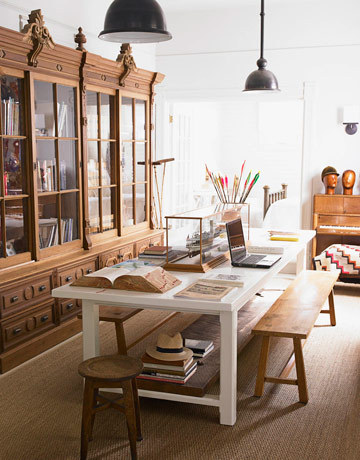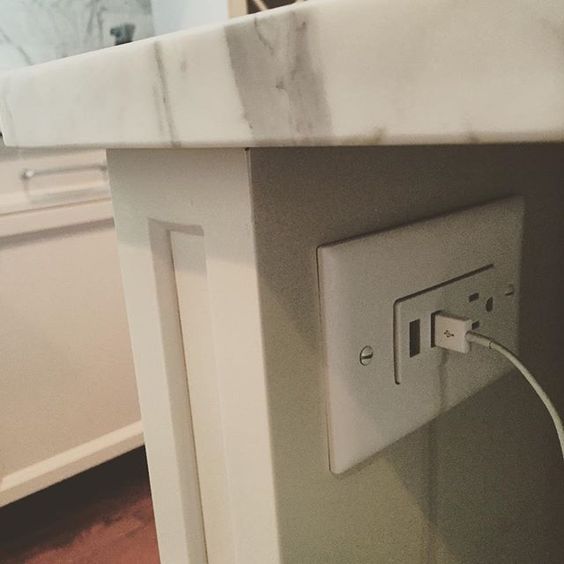The office is not the only work space that is evolving; a new level of electronic mobility -- coupled with intense electronic dependence -- is leading to changes in how homes are designed and how workspace is integrated into home life.
Rachael Franchescina of Fonda Interiors in Chicago, IL is a former corporate interior designer who now focuses on residential. She sees many parallels between what is happening in the office environment and in homes. In the recent history, most homes were designed with some variation of a desk area in the kitchen; however, Franchescina says that the last time she designed a true "desk space" into a kitchen was probably three years ago. She notes that even in residential the space dedicated for traditional "work tasks" is now much more integrated: "Activity-based planning is invading the home, too. Now when I do kitchens, I don't have touch down desk areas like we used to. They typically find it to be wasted space. People want to touch down at the island, the kitchen table, or even in front of the television." This means new postures, undedicated spaces, and even more integration of "work" and life.
![2016-03-11-1457661685-7538022-54c16e8f9ebf3__15hoefer0109de.jpg]()
What's driving these changes is very similar to the factors driving the change in the office environment. According to Francheschina, "It's about how technology is untethering us from even the home office. We now have phones and iPads that go wherever we go. Everything is definitely more mobile. I am not putting that many TVs in kitchens anymore because kids have iPads and phones, and because battery life is now five hours long, you don't need to be plugged in wherever you are." Ironically, though, even with long battery life, due to our intense inter-dependence on these electronic devices, there are also new expectations for accessibility of power anywhere and everywhere, and new needs for discreet charging options.
![2016-03-11-1457661730-6442406-d03dc269f67e9adf7869bf45230509c9.jpg]()
Overall, in homes we are starting to see a trend towards "right sizing." For a period of time, many people were building bigger and bigger homes with more and more space. Now, perhaps due to the sheer cost of real estate, environmental considerations, and generational influences, many more people are looking to downsize or right size. Francheschina adds, "In recent years, I have certainly been doing a lot less additions. People are beginning to shy away from huge suburban monstrosities that look just like each other. People are making smarter use of the space that they have rather than adding more."
Although the green movement is much more informal on the residential side, it is still a factor in this movement to right size, though it continues to be an unfortunate perception (and sometimes reality) that the greener you get the more expensive materials are. One major motivator in the right-sizing and greening of residential properties is environmental: once the home is built, it must be heated and cooled. In that regard, larger homes tend to be much more inefficient. Whether driven by cost or environmental considerations, the result is the same: smaller homes and smarter use of space.
Generational considerations also certainly have an effect. As baby boomers retire, they are downsizing. Francheschina says, "I feel like the millennials are a big part of what is driving this. They grew up in huge, oversized homes with intercom systems to talk to someone. Now research tells us that, in general, millennials tend to value experiences over 'things,' which leads to the desire for experiences over tangible pieces like real estate."
What does this mean with regards to the traditional "home office?" It means that much less space is being dedicated as formal office space, and it's becoming much more integrated. Now, this does not mean that the home office is going away for everyone. Many full time remote workers still have a dedicated office space, but for others things are beginning to look a bit different: Francheschina shares this example: "For a while nobody wanted a formal dining room. The kitchen island became the place where people gather and a space adjacent to the island was typically used for meals. Many turned formal dining rooms into a dedicated office. Now people are st
Rachael Franchescina of Fonda Interiors in Chicago, IL is a former corporate interior designer who now focuses on residential. She sees many parallels between what is happening in the office environment and in homes. In the recent history, most homes were designed with some variation of a desk area in the kitchen; however, Franchescina says that the last time she designed a true "desk space" into a kitchen was probably three years ago. She notes that even in residential the space dedicated for traditional "work tasks" is now much more integrated: "Activity-based planning is invading the home, too. Now when I do kitchens, I don't have touch down desk areas like we used to. They typically find it to be wasted space. People want to touch down at the island, the kitchen table, or even in front of the television." This means new postures, undedicated spaces, and even more integration of "work" and life.

What's driving these changes is very similar to the factors driving the change in the office environment. According to Francheschina, "It's about how technology is untethering us from even the home office. We now have phones and iPads that go wherever we go. Everything is definitely more mobile. I am not putting that many TVs in kitchens anymore because kids have iPads and phones, and because battery life is now five hours long, you don't need to be plugged in wherever you are." Ironically, though, even with long battery life, due to our intense inter-dependence on these electronic devices, there are also new expectations for accessibility of power anywhere and everywhere, and new needs for discreet charging options.

Overall, in homes we are starting to see a trend towards "right sizing." For a period of time, many people were building bigger and bigger homes with more and more space. Now, perhaps due to the sheer cost of real estate, environmental considerations, and generational influences, many more people are looking to downsize or right size. Francheschina adds, "In recent years, I have certainly been doing a lot less additions. People are beginning to shy away from huge suburban monstrosities that look just like each other. People are making smarter use of the space that they have rather than adding more."
Although the green movement is much more informal on the residential side, it is still a factor in this movement to right size, though it continues to be an unfortunate perception (and sometimes reality) that the greener you get the more expensive materials are. One major motivator in the right-sizing and greening of residential properties is environmental: once the home is built, it must be heated and cooled. In that regard, larger homes tend to be much more inefficient. Whether driven by cost or environmental considerations, the result is the same: smaller homes and smarter use of space.
Generational considerations also certainly have an effect. As baby boomers retire, they are downsizing. Francheschina says, "I feel like the millennials are a big part of what is driving this. They grew up in huge, oversized homes with intercom systems to talk to someone. Now research tells us that, in general, millennials tend to value experiences over 'things,' which leads to the desire for experiences over tangible pieces like real estate."
What does this mean with regards to the traditional "home office?" It means that much less space is being dedicated as formal office space, and it's becoming much more integrated. Now, this does not mean that the home office is going away for everyone. Many full time remote workers still have a dedicated office space, but for others things are beginning to look a bit different: Francheschina shares this example: "For a while nobody wanted a formal dining room. The kitchen island became the place where people gather and a space adjacent to the island was typically used for meals. Many turned formal dining rooms into a dedicated office. Now people are st